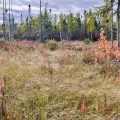Isabel Kim is a Pittsburgh Media Partnership 2025 summer intern.
A new study shows that small differences in temperature and humidity within a farm field can affect flowering plants and how many bees they attract.
LISTEN to the story
Wyman’s, one of the largest wild blueberry producers in the United States, started noticing a pattern on its wild blueberry farm in Maine. Some parts of the field were full of berries, while others were not.
“But there was no obvious reason,” said Penn State Entomology professor Christina Grozinger.
Wyman’s reached out to Pennsylvania researchers, including Grozinger, to find out why. They formed a collaboration between the Penn State Center for Pollinator Research and the University of Pittsburgh.
“We decided to tackle this mystery by developing new strategies for monitoring and modeling crop yield, pollinator activity, and environmental variation,” she said.
How the study was conducted
They monitored a 170-acre wild blueberry farm in Maine, looking closely at what are known as microclimates, which are small areas within the same field that vary in temperature and humidity.
The researchers divided the field into 120 plots, and used sensors to track environmental changes every ten minutes across the field while flowers on the blueberry plants were in bloom.
“There is wide variation in temperature across the field, which could be as high as 10℃,” said Dr. Vikas Khanna, a professor of Civil and Environmental Engineering at the University of Pittsburgh and co-author of the study. “There were also differences in relative humidity, which is close to 30%.”
They also tracked the location and number of honey bee hives, as well as flower density, and blueberry yields.
“Warmer areas tend to see higher flower density, and that in turn affects bee activity. Bees tend to visit areas that have more flowers,” he said.
The researchers said that even with the abundant level of managed honey bees at the warmer site, they did not find a reduced number of wild bees.
A way to help troubled pollinators
Bees and other pollinators have been declining worldwide. Climate change, floral availability, and nesting habitats have been identified as contributing factors.
The study suggests that microclimate-aware farm practices, like hive placement and patches of natural habitat, may help pollinators adapt to changing weather and climate.
Khanna said their findings could help farmers adjust hive placement to optimize crop yields.
On the Penn State website, Dr. Heather Grab, assistant professor in the College of Agricultural Sciences and lead author on the paper, explained that precision agriculture, which measures temperature and humidity microclimates within a field, can also be used to help pollinators.
“Remote sensing techniques could measure flower density patterns across the field and identify low blooming regions,” Grab said. “Which may be a promising method…to suggest removing low-performing sites from production, perhaps to the benefit of increasing areas for biodiversity conservation.”
The researchers said future studies could look at whether the micro patterns they found connecting temperature and humidity variabilities with flower and bee populations could also be found in broader regions and in different years.




